CompoTech highlights fiber laying technologies to achieve CFRP preform, component versatility
Automated fiber laying (AFL) placement and winding machine technologies enhance OEM capabilities to produce reliable, commercially viable custom composite products.
CompoTech’s AFL machine is able to cost-effectively make a unidirectional flat pitch fiber preform on a PAN fiber fabric backing. Source | CompoTech Plus
CompoTech Plus (Sušice, Czech Republic), through its automated fiber laying (AFL) placement and winding machine technology developments, offers a reliable, commercially viable alternative to new product development (NPD) using specialized carbon and aramid technical fibers. It also offers additional manufacturing versatility to carbon fiber preforms and final composite component production.
The prohibitive cost of producing bespoke specialty fabrics in small quantities often hinders development of novel, high-performance composite part designs, CompoTech explains. For most technical fabric producers, it is not practical or viable to set up and customize small-volume batches, especially with delicate ultra-high modulus woven fabrics or noncrimp fabrics (NCFs). Therefore, NPD often doesn’t progress to prototyping and final composite component production.
As a solution, the versatile production capabilities of CompoTech’s automated machine and control software enables the production, on the same machine, of carbon and aramid fiber NCFs, variably shaped dry fiber preforms and finished fiber-reinforced epoxy composite parts. Through its production technology, CompoTech reports that it has been able to develop new component designs, and to work with OEM customers to provide prototypes and manufacture one-off or limited volume components for high-performance applications in aerospace, bespoke industrial production machinery and specialist metrology equipment.
CompoTech’s AFL placement and winding machine technology is able to process pitch and polyacrylonitrile (PAN) carbon fiber, aramid or other high-performance fibers. Fabrics and variably shaped dry fiber preforms can be produced as part of a two-stage process. The first stage uses only a single bobbin loaded with the exact quantity of fibers required to make the preform or fabric needed in the specified dimensions for the component. A preform on a flat woven fabric backing can be produced via dry layup in a mold, or the preform can be laid directly onto a round, square or rectangular tool. The second processing stage, using the same machine, is to overwind with wet fibers — in any orientation — to produce the final fiber-reinforced epoxy component. CompoTech says its technology is also capable of making dry fabrics with multiaxial or unidirectional orientation, which can be used as preforms up to 6 meters long in vacuum infusion/RTM processes.
CompoTech’s AFL and winding technologies are integrated with a FANUC (Rochester Hills, Mich., U.S.) six-axis robot arm that enables wide-ranging, production flexibility of the automated system, combined with proprietary control software that provides simple protocols for precision fiber application. Its “zero-degree” carbon fiber axial placement, precise places PAN fibers, as well as more delicate “pitch” fibers, without damaging them.
This has resulted in components with enhanced mechanical properties that are typically 25% lighter than steel and with the same stiffness. This offers enhanced efficiency and productivity. For instance, CompoTech is capable of producing parts like composite beams, rotary shafts, spindles and tools for production machines and automated lines, particularly in industrial applications where high stiffness and natural frequency are required.
Moreover, for manufacturers looking to install in-house automated dry fabric, preform and carbon fiber composite component production capabilities, CompoTech now offers customers turnkey automated fiber winding and filament placement machines. Each automated machine comes with CompoTech’s winding technologies and control software included as standard, along with after-sales technical and product development support.
Related Content
PEEK vs. PEKK vs. PAEK and continuous compression molding
Suppliers of thermoplastics and carbon fiber chime in regarding PEEK vs. PEKK, and now PAEK, as well as in-situ consolidation — the supply chain for thermoplastic tape composites continues to evolve.
Read MoreHeat mapping simulation to improve AFP parts
An optical model developed for Coriolis Composites’ SimuReal AFP process simulation software enables verification of energy distributions during AFP to better define heating laws.
Read MoreThe next evolution in AFP
Automated fiber placement develops into more compact, flexible, modular and digitized systems with multi-material and process capabilities.
Read MoreManufacturing the MFFD thermoplastic composite fuselage
Demonstrator’s upper, lower shells and assembly prove materials and new processes for lighter, cheaper and more sustainable high-rate future aircraft.
Read MoreRead Next
CompoTech spotlights sustainable advancements in BOVENAC project
CompoTech highlights its efforts in the BOVENAC project, specifically for advancements in the design and functionality of composite joint shafts for 4WD vehicles.
Read MoreCompoTech uses integrated loop technology to create high-performance mountain bike
CompoTech features its CDuro Epona mountain bike fitted with custom suspension forks, manufactured using its AFL winding and integrated loop technologies.
Read MoreVIDEO: High-volume processing for fiberglass components
Cannon Ergos, a company specializing in high-ton presses and equipment for composites fabrication and plastics processing, displayed automotive and industrial components at CAMX 2024.
Read More











.jpg;maxWidth=300;quality=90)












